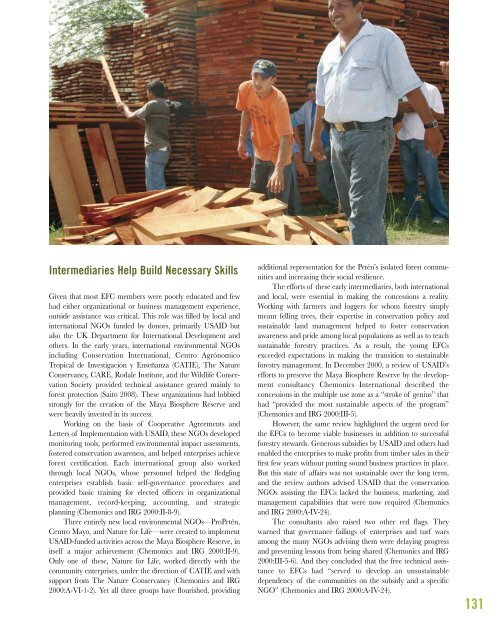Growing the Wealth of the Poor - World Resources Institute
Growing the Wealth of the Poor - World Resources Institute
Growing the Wealth of the Poor - World Resources Institute
You also want an ePaper? Increase the reach of your titles
YUMPU automatically turns print PDFs into web optimized ePapers that Google loves.
Intermediaries Help Build Necessary SkillsGiven that most EFC members were poorly educated and fewhad ei<strong>the</strong>r organizational or business management experience,outside assistance was critical. This role was filled by local andinternational NGOs funded by donors, primarily USAID butalso <strong>the</strong> UK Department for International Development ando<strong>the</strong>rs. In <strong>the</strong> early years, international environmental NGOsincluding Conservation International, Centro AgrónomicoTropical de Investigación y Enseñanza (CATIE), The NatureConservancy, CARE, Rodale <strong>Institute</strong>, and <strong>the</strong> Wildlife ConservationSociety provided technical assistance geared mainly t<strong>of</strong>orest protection (Saito 2008). These organizations had lobbiedstrongly for <strong>the</strong> creation <strong>of</strong> <strong>the</strong> Maya Biosphere Reserve andwere heavily invested in its success.Working on <strong>the</strong> basis <strong>of</strong> Cooperative Agreements andLetters <strong>of</strong> Implementation with USAID, <strong>the</strong>se NGOs developedmonitoring tools, performed environmental impact assessments,fostered conservation awareness, and helped enterprises achieveforest certification. Each international group also workedthrough local NGOs, whose personnel helped <strong>the</strong> fledglingenterprises establish basic self-governance procedures andprovided basic training for elected <strong>of</strong>ficers in organizationalmanagement, record-keeping, accounting, and strategicplanning (Chemonics and IRG 2000:II-8-9).Three entirely new local environmental NGOs—ProPetén,Centro Mayo, and Nature for Life—were created to implementUSAID-funded activities across <strong>the</strong> Maya Biosphere Reserve, initself a major achievement (Chemonics and IRG 2000:II-9).Only one <strong>of</strong> <strong>the</strong>se, Nature for Life, worked directly with <strong>the</strong>community enterprises, under <strong>the</strong> direction <strong>of</strong> CATIE and withsupport from The Nature Conservancy (Chemonics and IRG2000:A-VI-1-2). Yet all three groups have flourished, providingadditional representation for <strong>the</strong> Petén’s isolated forest communitiesand increasing <strong>the</strong>ir social resilience.The efforts <strong>of</strong> <strong>the</strong>se early intermediaries, both internationaland local, were essential in making <strong>the</strong> concessions a reality.Working with farmers and loggers for whom forestry simplymeant felling trees, <strong>the</strong>ir expertise in conservation policy andsustainable land management helped to foster conservationawareness and pride among local populations as well as to teachsustainable forestry practices. As a result, <strong>the</strong> young EFCsexceeded expectations in making <strong>the</strong> transition to sustainableforestry management. In December 2000, a review <strong>of</strong> USAID’sefforts to preserve <strong>the</strong> Maya Biosphere Reserve by <strong>the</strong> developmentconsultancy Chemonics International described <strong>the</strong>concessions in <strong>the</strong> multiple use zone as a “stroke <strong>of</strong> genius” thathad “provided <strong>the</strong> most sustainable aspects <strong>of</strong> <strong>the</strong> program”(Chemonics and IRG 2000:III-5).However, <strong>the</strong> same review highlighted <strong>the</strong> urgent need for<strong>the</strong> EFCs to become viable businesses in addition to successfulforestry stewards. Generous subsidies by USAID and o<strong>the</strong>rs hadenabled <strong>the</strong> enterprises to make pr<strong>of</strong>its from timber sales in <strong>the</strong>irfirst few years without putting sound business practices in place.But this state <strong>of</strong> affairs was not sustainable over <strong>the</strong> long term,and <strong>the</strong> review authors advised USAID that <strong>the</strong> conservationNGOs assisting <strong>the</strong> EFCs lacked <strong>the</strong> business, marketing, andmanagement capabilities that were now required (Chemonicsand IRG 2000:A-IV-24).The consultants also raised two o<strong>the</strong>r red flags. Theywarned that governance failings <strong>of</strong> enterprises and turf warsamong <strong>the</strong> many NGOs advising <strong>the</strong>m were delaying progressand preventing lessons from being shared (Chemonics and IRG2000:III-5-6). And <strong>the</strong>y concluded that <strong>the</strong> free technical assistanceto EFCs had “served to develop an unsustainabledependency <strong>of</strong> <strong>the</strong> communities on <strong>the</strong> subsidy and a specificNGO” (Chemonics and IRG 2000:A-IV-24).131
















